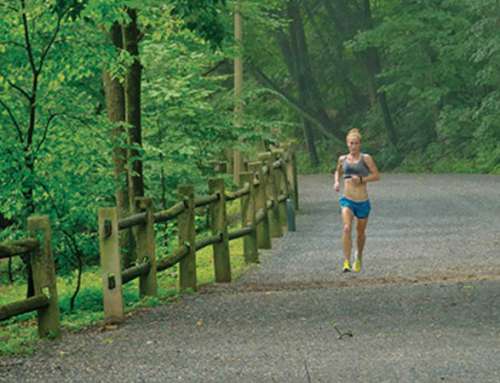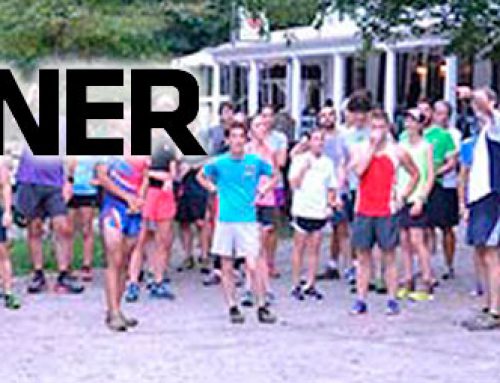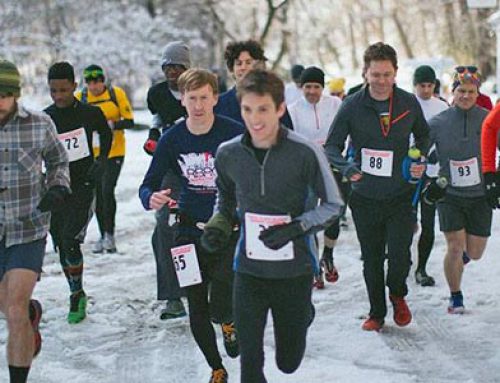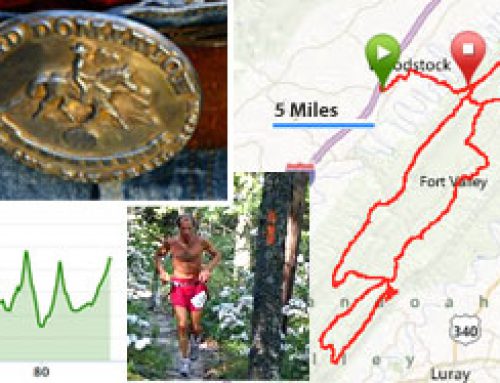Spring is about to be sprung so the Wanderer track workouts are moving from the Roxborough High School track to the Chestnut Hill Academy track starting on Tuesday, March 17. This changeover seems like an opportune time to highlight the benefits of track workouts. Read on for common questions and answers by some Wanderer track workout regulars.
Long distance runners often shy away from track workouts for a variety of reasons: “It looks too much like work!” “I will be embarrassed.” “I might get hurt” are among the myriad of excuses. Marc Zisselman, Sharon Schmidt and Polly Jansen regularly lead the track workouts for the Wanderers. To dispel the aversion many distance runners have toward the track, the three Wanderer experts were asked questions on why the track workouts are so important. Here are their answers.
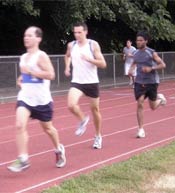 Question: What special benefits do you think the track workouts provide for runners?
Question: What special benefits do you think the track workouts provide for runners?
Sharon: The most obvious benefit of track running is that you should notice some gains in speed. It won’t be overnight but over time, your legs will move and turnover a little faster, and you’ll be more physiologically efficient. And for people with schedule demands: if you are more efficient, you can get more done in the same amount of time…or the same amount done in less time!
Track workouts also teach your lungs to process more oxygen more efficiently. So not only will you be faster, but you’ll be able to run harder for longer. You’ll sometimes be uncomfortable while running on the track. By experiencing some discomforts in training, and forcing your body to learn to adapt, you’ll be better prepared to handle it during a race. Track workouts will force you to appropriately pace yourself. When you are racing, or even doing long runs by yourself, you need to be realistic in your pace and not start too aggressively. On training runs, on the track, and while racing, you don’t want to feel so exhausted at the end that another step is hard…or still be full of energy.
And, contrary to some old beliefs, track workouts are a great way to burn fat. Your metabolism stays higher for longer, so you keep burning fat long after you are finished running.
Besides, isn’t just running fast fun sometimes?
Marc: Track workouts are designed to help runners get comfortable running at a faster than “usual” pace which will ultimately result in being able to sustain faster paces over longer distances.
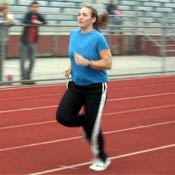 Question: Do you think that track workouts are suitable for all runners, or just for more high performance runners?
Question: Do you think that track workouts are suitable for all runners, or just for more high performance runners?
Sharon: Track workouts are great for everyone – high performance/competitive runners (any distance!), runners who never want to race, experienced runners, and beginner runners (see below). The most effective running routine varies in the type of runs with different runs teaching the muscles different lessons. Track workouts are just one component in creating a well-rounded running program. Even if a runner does not care about getting faster, you can become more efficient and complete a terrific workout in less time.
Question: How have the track workouts helped you in your training?
Polly: I have really found that they help my overall running. It gives you a chance to think about and work on your form as well as pushing yourself to your upper limits. Even just one speed work-out a week can help you increase your pace and running efficiency. The group work-outs are great because of the variety of paces and we also help to motivate each other.
Sharon: I can feel that I’m a lot stronger, both mentally and physically, after running track workouts. I can run harder for a longer period of time; I didn’t build that strength by adding lots of miles on the road. I also have a much better feel for pace and know when my body is feeling a good or bad discomfort and can hang in there or adjust accordingly.”
Question: If a runner has not tried a track workout before, how should that person get started?
Sharon: The first step in a track workout is to make the commitment and show up. Speed training by yourself is a difficult commitment to make and follow through with. That’s what’s great about the Wanderers. Showing up on a Tuesday night at the track, you are always going to find at least one other person there. And having a partner always makes a track workout more fun and easier to see through to the end.
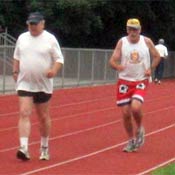 Question: Give us examples of two track workouts?
Question: Give us examples of two track workouts?
Sharon: We try to keep some variety in the workouts to keep everyone from getting bored and make the body adjust to new stresses. If a large group of “regulars” are training for specific runs, we’ll tailor the workouts for that distance. Here are a couple examples of workouts we’ve done in the past: Ladder: 400, 800, 1200, 1200, 800, 400 with recovery of 90 – 120 seconds….or the more challenging inverse of “climbing down” the ladder and then back up. Repeat 400’s: anywhere from 10 – 14 400’s with 30 – 60 seconds recovery. (Editor’s note: Beginning runners can and should run just a fraction of these workouts and then build up. For instance, start with four or five 440 repeats, and then build the number as you get stronger.)
Marc: I like to emphasize working to a goal pace with a fairly short recovery time. Initially ‘I gear toward’ the Broad Street Run pace, but later I emphasize shorter distances as it warms up.
Question: Injuries can be a problem. How do you avoid them?
Marc: Warm up adequately. Maintain form. This is not a race. Start a bit slower than you think you are capable of. Go at a pace you can sustain for the entire workout. Take an easy or off day before and after the workout…more if you are a balding middle aged man.
Sharon: So that a runner does not end up injured from starting track workouts, a runner should probably have at least 6 months of consistent running under their legs, averaging around 20 miles/week. Once someone has a good base, show up at the track. Let any of the other runners know, or the person who designed the workout, that you are beginner on the track. (And remember, everyone started as a newbie on the track at some point!) They’ll start you off gradually on shorter distances and longer recovery periods, lengthening and shortening these, respectively, as a runner gets stronger and the body adapts to the speed workouts.
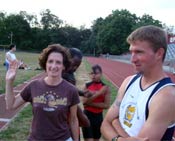 Question: Other Comments?
Question: Other Comments?
Sharon: Running track workouts with a group is very beneficial. You’re more likely to commit when you know others will be with you. You have companionship and other runners that will push you…or you’ll push them. Either way, having others on the track with you is motivating!
If you want to improve your running, you’ve got to have variety and get out of your comfort zone. Speed workouts will take you there!



